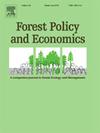具有多个碳库的广义福斯特曼模型
IF 4
2区 农林科学
Q1 ECONOMICS
引用次数: 0
摘要
在 "碳中和 "的背景下,准确计算森林固碳量(包括活树生物量、死亡有机物和伐木制品)至关重要。本研究建立了一个广义的福斯特曼模型,包括在不同的伐木制品衰变模式假设下多个碳库的固碳。然后,对死亡有机物和伐木制品碳库的关键参数进行了比较静力学分析。结果表明,死亡有机物和伐木制品碳库参数对最佳轮伐的影响通常取决于经济环境,如折现率和变化时间。案例研究结果表明,考虑多个碳库的固碳作用可提高土地期望值和林地碳储量。同时,不同的伐木产品类型和腐朽模式对最佳轮伐期的影响也不同。我们的研究结果表明,应针对不同类型的采伐木产品建立不同的碳核算方法,如纸和纸板采用指数衰变法,实木制品采用卡方衰变法。此外,还有必要扩大木基建筑材料中伐木制品的销路,并延长其半衰期。本文章由计算机程序翻译,如有差异,请以英文原文为准。
A generalized Faustmann model with multiple carbon pools
In the context of “carbon neutrality”, it is crucial to accurately account for forest carbon sequestration, including living tree biomass, dead organic matter, and harvested wood products. This study develops a generalized Faustmann model, including carbon sequestration in multiple carbon pools under different assumptions of the decay modes of harvested wood products. Then, a comparative statics analysis of key parameters of dead organic matter and the harvested wood product carbon pool is conducted. The results show that the effect of the carbon pool parameters of dead organic matter and harvested wood products' on the optimal rotation usually depends on the economic environment, such as the discount rate and the time of their changes. Results of our case study indicate that considering the carbon sequestration in multiple carbon pools increases land expectation value and forest land carbon stocks. Meanwhile, different harvest wood products types and decay modes affect the optimal rotation differently. Our results demonstrate that different carbon accounting methodologies should be established for different types of harvested wood products, such as exponential decay for paper and paperboard and chi-square decay for solid wood products. It is also necessary to expand the outlets of harvested wood products in wood-based building materials and extend their half-lives.
求助全文
通过发布文献求助,成功后即可免费获取论文全文。
去求助
来源期刊

Forest Policy and Economics
农林科学-林学
CiteScore
9.00
自引率
7.50%
发文量
148
审稿时长
21.9 weeks
期刊介绍:
Forest Policy and Economics is a leading scientific journal that publishes peer-reviewed policy and economics research relating to forests, forested landscapes, forest-related industries, and other forest-relevant land uses. It also welcomes contributions from other social sciences and humanities perspectives that make clear theoretical, conceptual and methodological contributions to the existing state-of-the-art literature on forests and related land use systems. These disciplines include, but are not limited to, sociology, anthropology, human geography, history, jurisprudence, planning, development studies, and psychology research on forests. Forest Policy and Economics is global in scope and publishes multiple article types of high scientific standard. Acceptance for publication is subject to a double-blind peer-review process.
 求助内容:
求助内容: 应助结果提醒方式:
应助结果提醒方式:


